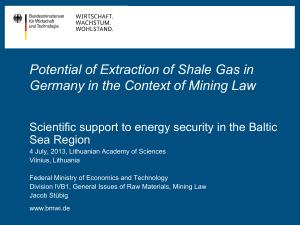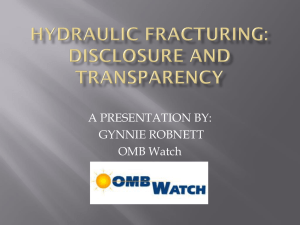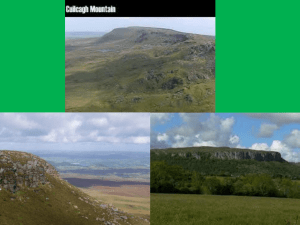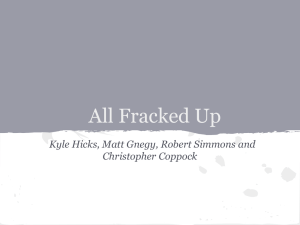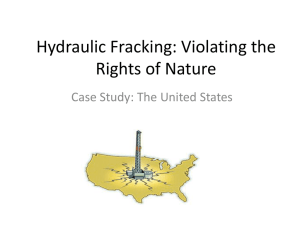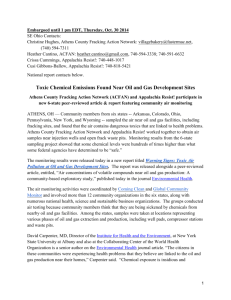Document
advertisement
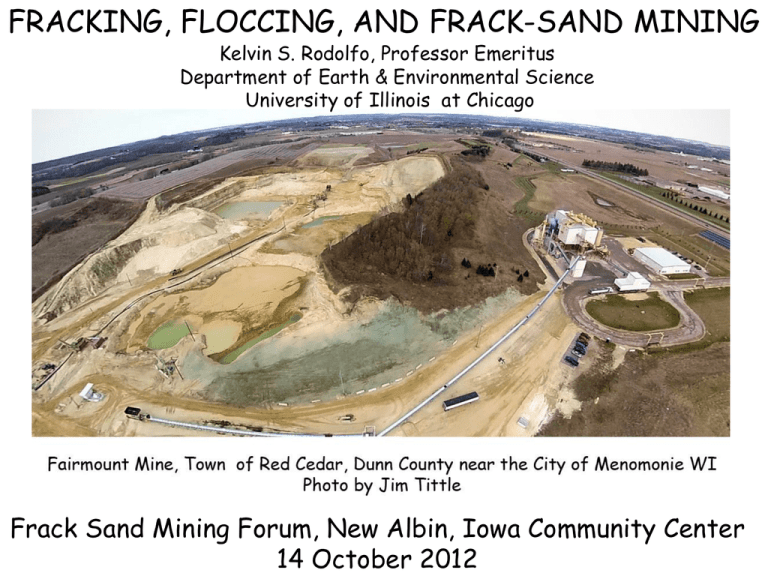
FRACKING, FLOCCING, AND FRACK-SAND MINING Kelvin S. Rodolfo, Professor Emeritus Department of Earth & Environmental Science University of Illinois at Chicago Frack Sand Mining Forum, New Albin, Iowa Community Center 14 October 2012 Topics What is “fracking”? Where is fracking done? What are fracking sands? How did the Driftless area’s fracking sands form? Environmental consequences of frack-sand mining Fracking won’t happen here, so is it OK for us to provide sand for fracking elsewhere? IF THERE IS ENOUGH TIME: Environmental consequences of fracking Groundwater pollution Methane leakage and global warming Does fracking cause earthquakes? Consequence or staying hooked on natural gas and other fossil fuels TRADITIONAL OIL AND GAS SITUATION Most traditional oil/gas traps are now empty; fracking extracts oil and gas DIRECTLY from the source shales Impermeable cap rock Natural gas Oil Reservoir rock, porous sandstone Source rock: fine-grained clay shale holding tiny dispersed oil droplets and/or bubbles of natural gas clinging to clay grains Unlike traditional production from oil traps in very rare places under small areas, fracking operations are very widespread and involve many more drilling rigs. So many more people are affected. Hydraulic fracturing; induced hydraulic fracturing; hydrofracturing; hydrofracking. Wells drilled 1-2 miles deep into fine-grained shales, then horizontally as much as 10,000 feet. Fracking fluid forced under high pressure (5,000 PSI) to fracture the shale. Fluid consists mostly of water and many chemicals, plus strong, round sand grains (“proppants”) to keep fractures propped open so gas or oil can escape and be collected. 5,000 psi 1-2 miles Sand grains prop fractures open 10,000 feet Fracking can use 2 to 3 million US gallons of fluid per well. Typical well uses 100,000 gallons of chemical additives of varying toxicity 4,000 U.S. Oil Production, Millions of Barrels per Day Despite greatly increased drilling, oil production continues to decline . . . 12 10 Fracking boom 8 2011 3,000 2,000 Sources: Baker Hughes, Inc., Energy Information Administration, and Green Econometrics Research http://greenecon.net/wp-content/uploads/w2008/2009/us_oil.jpg 2010 2000 1990 1980 1970 2 1960 0 6 4 1,000 1950 Active Drilling Rigs Oil and Gas Drilling in the U.S. Since 1950 0 . . . But U.S. Natural Gas Production is Booming! http://peakwatch.typepad.com/.a/6a00d83452403c69e20133ecc4d8ef970b-800wi Oil/Gas shale prospect areas None in WI or IA, but frack sand is abundant! Proposed New Albin IA North America 550 - 450 million years ago LAND New Albin Most of North America covered by a warm, shallow sea, no deeper than 100 feet. Areas were sometimes above and sometimes below sea level for tens of millions of years. Granites and other rocks far “north” of our area were sources of quartz sands. www3.interscience.wiley.com:8100/.../le08_26.jpg Nature expended huge amounts of time and energy to make well rounded, well sorted quartz sand grains. The most important benefit to humankind: Such deposits make the best groundwater aquifers. But the same properties also make the sands the most abundant “proppants” for fracking. Frack sand Mesh# 8/12 Size, mm 2.38-1.68 Size, inch 0.094-0.066 (30 to 60 grains side by side sizes make one inch) 10/20 2.00-0.84 0.079-0.033 20/40 70/140 0.84-0.42 0.21-0.105 0.033-0.0165 0.009-0.004 Preferred and most widely used Ideal “proppants”: Hard, tough, chemically durable, round Quartz grains Granite: Typical original source of quartz grains. When weathered and worked by streams, waves and the wind for tens of millions of years, all minerals are destroyed except quartz grains, which are rounded.


